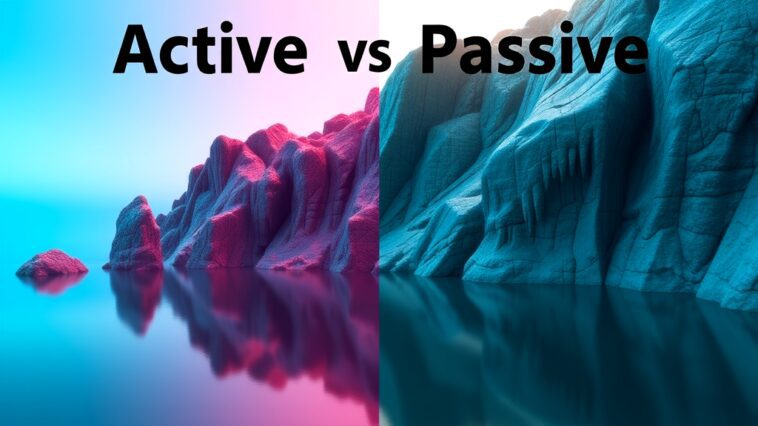Introduction
Have you ever watched a movie in 3D and felt like the characters were jumping out of the screen? For a while, 3D TVs were all the rage, and many people loved the experience they offered. However, from around 2016, the production of 3D TVs began to decline. Today, we hardly hear about them. But what exactly is 3D technology in TVs, and what are the differences between active and passive 3D? This article aims to compare these two technologies and help you understand which one might be better for you.
1. Understanding 3D Technology
1.1 What is 3D Technology?
3D technology is all about creating a three-dimensional experience on a two-dimensional screen. It tricks your brain into perceiving depth, making images appear more lifelike. When you watch a 3D movie, your brain combines two slightly different images (one for each eye) to create the illusion of depth. To make this work, the TV uses special techniques to ensure that each eye sees the right image. This is where the differences between active and passive 3D come into play, especially when it comes to viewing angles and how well you can see the 3D effect.
2. Active Shutter 3D Technology
2.1 How Active Shutter 3D Works
Active shutter 3D technology uses special glasses that have electronic shutters. These glasses alternate the images that each eye sees in perfect sync with the TV. For example, when the left eye sees one frame, the right eye sees the next frame, and so on. This rapid switching creates a 3D effect. Because of this fast switching, the images can have a high resolution, making them very detailed.
2.2 Advantages of Active Shutter 3D
One of the biggest advantages of active shutter 3D is that it provides higher resolution and detail. You can see sharp images and fine details that make the viewing experience more immersive. It is also better for fast-paced content, such as action movies or video games, where quick movements are common and you don’t want to miss anything.
2.3 Disadvantages of Active Shutter 3D
However, there are some downsides to active shutter 3D. Some people may experience flickering, which can be distracting. Crosstalk, or ghosting, can also happen when images from one eye bleed into the other, ruining the 3D effect. Additionally, the glasses can be expensive and require batteries, which means more costs for you. Some viewers may experience discomfort, such as headaches or eye strain, after wearing the glasses for a long time.
3. Passive 3D Technology
3.1 How Passive 3D Works
Passive 3D technology works differently. Instead of using active glasses, it uses simpler, lightweight glasses that don’t need batteries. It combines the left and right images on the screen, which means each eye sees a different image through the glasses. However, this method halves the vertical resolution of the image because it shares pixels between the two eyes.
3.2 Advantages of Passive 3D
One of the main benefits of passive 3D is that it is more comfortable. The glasses are usually lightweight and inexpensive, making it easy for everyone to wear them. There’s also less flickering, making the viewing experience smoother, and people generally report less discomfort when watching passive 3D. Many viewers find that passive 3D provides better depth perception, allowing them to enjoy the 3D effect more easily.
3.3 Disadvantages of Passive 3D
On the flip side, passive 3D has some downsides. Since it halves the vertical resolution, the images may not be as sharp as those in active 3D. The screen also tends to appear dimmer when displaying 3D content, which can affect the overall viewing experience, especially in brightly lit rooms.
4. Comparison of Active vs Passive 3D
When comparing active and passive 3D, there are several key differences. Active 3D typically offers higher performance and detail, making it ideal for fast-paced movies and games. However, it comes at a higher cost and can cause discomfort. Passive 3D is more budget-friendly and comfortable, but it sacrifices some image quality and brightness.
Both technologies also affect how 2D content is displayed. Active 3D TVs often have better overall image quality for 2D content, while passive 3D TVs may not perform as well. Additionally, screen brightness and HDR (High Dynamic Range) compatibility can make a big difference. Active 3D TVs generally support HDR better, enhancing the color and contrast of the images.
5. The Future of 3D Displays
5.1 Innovations in 3D Technology
While 3D TVs may not be as popular as they once were, innovations in 3D technology continue to emerge. One such innovation is SpatialLabs, which offers glasses-free 3D displays. These displays use advanced eye-tracking technology and lenticular lenses to create a 3D effect without the need for glasses. Such advancements could change the way we experience 3D content in the future.
5.2 Current Market Offerings
Today, there are still products on the market that cater to specific audiences, like gamers or designers. Some gaming monitors offer 3D capabilities using active shutter technology, while certain specialized displays focus on 3D modeling in design work. Prices for these modern displays can vary widely, from a few hundred to several thousand dollars, depending on the technology and features.
6. Conclusion
In summary, both active and passive 3D technologies offer unique experiences, each with its own set of advantages and disadvantages. Active 3D provides higher resolution and detail, making it great for fast-paced content, but it can be uncomfortable and costly. Passive 3D is more comfortable and affordable but sacrifices some resolution and brightness.
When choosing between the two, consider your interests and how you plan to use the technology. If you’re a big fan of action movies or gaming, you might lean toward active 3D. However, if comfort and affordability are more important, passive 3D could be the way to go. Regardless of the choice, it’s essential to remember that 3D technology continues to evolve, and new innovations may bring exciting experiences in the future.
Other Related Articles
- Eizo Foris FS2331 Review
- How Much Power Does a 144Hz Monitor Use? A Deep Dive into Energy Consumption
- Should I Turn On HDR for Gaming? A Comprehensive Guide
- Is iPhone 16 Pro OLED the Best Display Yet?
- Understanding Panel Variance: What It Means for Your Monitor Purchase
- Can You Throw Computer Monitors in the Trash? The Ultimate Guide to Eco-Friendly Disposal
- Understanding VESA ClearMR: The Future of Motion Clarity in Displays
- 4K vs 1080p – Is UHD Worth The Upgrade?
- How To Choose The Right Gaming Monitor: A Comprehensive Guide
- IPS vs OLED Monitors for Color Accuracy: The Ultimate Showdown
- HDMI 2.1: The Future of Home Entertainment and Gaming
- How to Connect Heart Rate Monitor to PC?
- Curved vs Flat TV – Which Should You Choose? The Ultimate Showdown for 2025
- Can You Connect M-Audio Monitors to PC?
- Why Is My PC Showing the Same Display on Two Monitors?
- Why Are Computer Monitors More Expensive Than TVs?
- The Best Flicker-Free Monitors for Eye Care
- Monitors for Mac vs Windows PCs: The Ultimate Showdown
- 1920×1080 vs 2560×1440 – Which One Should I Choose?
- 99219444 Toshiba and Its Revolutionary Features for Tomorrow’s Tech Landscape
- OLED vs QD-OLED: The Showdown of Display Technologies
- What Is DisplayPort 2.1?
- What Is The Best Monitor Size For Gaming?
- 720p vs 1080p vs 1440p vs 4K vs 8K – Which Should I Choose?
- Is An HDR Gaming Monitor Worth It?
- Mini-LED vs MicroLED: What’s the Difference?
- Do Pawn Shops Take Computer Monitors?
- What LG Computer Monitor is as Good as the C3?
- Understanding Pixel Walk and Pixel Inversion
- Curved vs Flat Monitors for Work: Which One is Right for You?
- What Is The Soap Opera Effect?
- 4K vs 1440p Monitors for Video Editing: Which One Should You Choose?
- Do I Have to Attach a Hood to My BenQ Monitor?
- Can You Use Mac as a Monitor for PC?
- What Is G-SYNC And What Does It Do?
- Daz Studios Summoner G8 for the Visionary Artist
- Dell vs HP Monitors for Gaming
- Understanding IPS Technology: A Comprehensive Guide
- 27-Inch Monitors vs 32-Inch Monitors for Productivity
- Understanding Screen Resolution: Why It Matters for Your Displays
- How to Transport Computer Monitors?
- How to Dispose of Computer Monitors?
- What Is 4K Resolution And Is It Worth It?
- How to Pack Computer Monitor for Moving?
- What Is HDR For TVs And Is It Worth It?
- 1440p or 144Hz – Which Is Best For You?
- USB Type-C Explained – Everything You Need To Know
- Samsung’s Exciting Journey into Glasses-Free 3D Displays at Gamescom 2024
- I Have A Problem with My Samsung Odyssey G3 Monitor Setup
- Is A 144Hz Monitor Worth It? A Comprehensive Guide
- Understanding FALD Blooming and the Halo Effect: A Deep Dive
- What Does 144Hz Mean? Understanding Refresh Rates in Simple Terms
- Is an UltraWide Monitor the Right Choice for You?
- Active vs Passive 3D – What’s The Difference?
- Understanding Glare Control in Luminaires for Computer Users
- Why Does My Acer Monitor Keep Going Black?
- Understanding Motion Blur Reduction: A Gamer’s Guide
- How to Connect Studio Monitors to PC?
- Misleading Monitor Specifications You Should Look Out For
- QLED vs OLED – Which Is Best?
- Understanding VESA AdaptiveSync and MediaSync: The Future of Display Technology




